#oura catholic church
Text
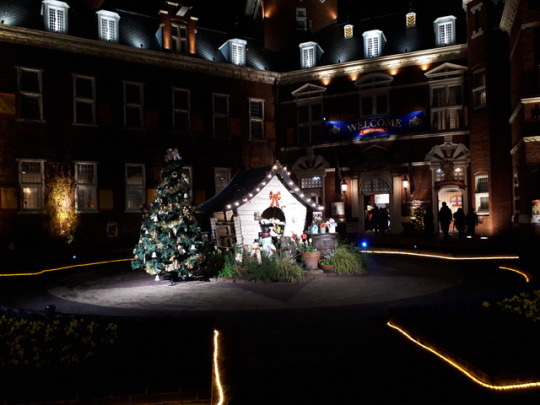
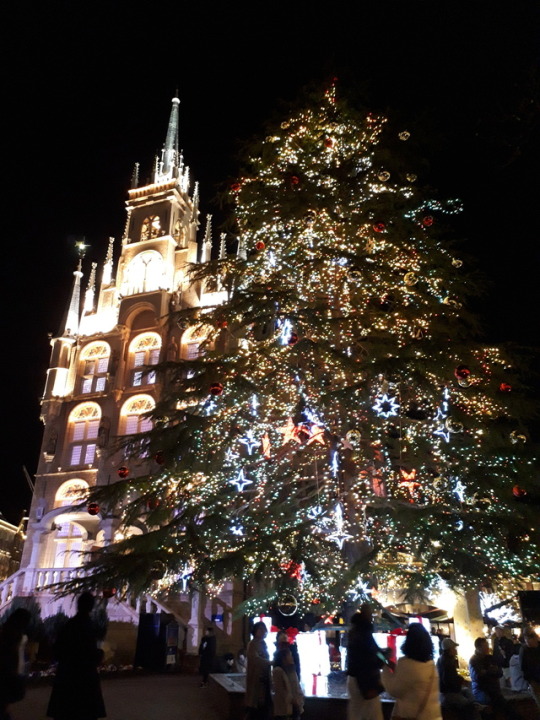

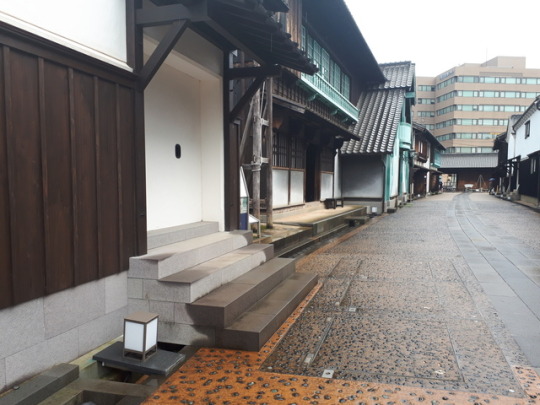



4 notes
·
View notes
Text
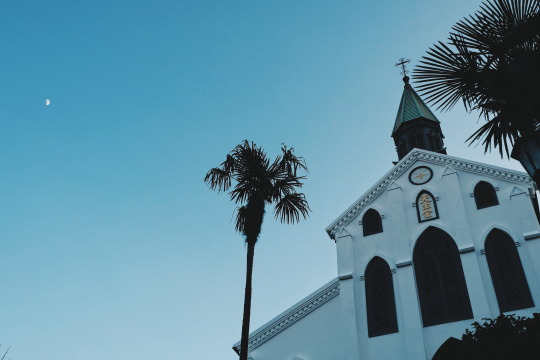
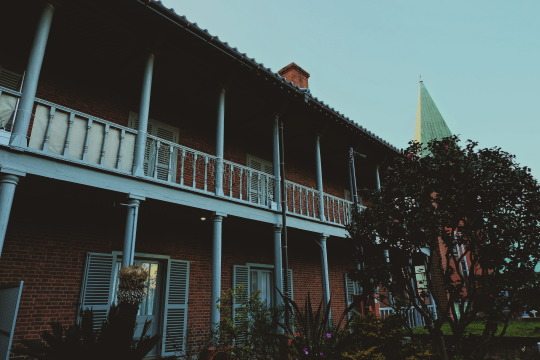
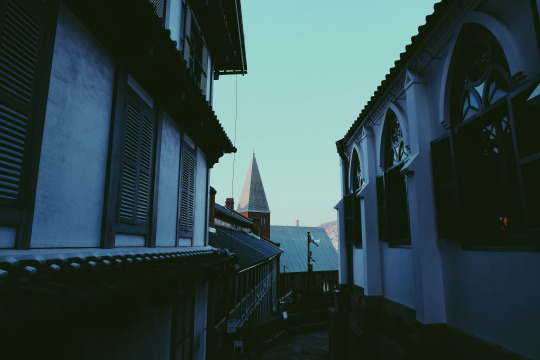
#original photography on tumblr#photography#japan#japanese#Oura Cathedral#church#catholic#catholic church#historic building#japanese landscape#landmark#landscape#blue#Nagasaki#Nagasaki city#Oura#world Heritage#Churches and Christian Heritage Sites in Nagasaki#大浦天主堂#教会#カトリック教会#長崎#長崎市#世界遺産#長崎の教会群とキリスト教関連遺産
72 notes
·
View notes
Photo

The Great Catholic Church by yu_kon
4 notes
·
View notes
Photo

The Great Catholic Church by yu_kon
1 note
·
View note
Photo

The Great Catholic Church by yu_kon
1 note
·
View note
Note
Hii Mr J and landlady! I am visiting japan in two weeks. Are there any historic landmarks or fun places you think I should definitely see?
Wow, that sounds nice! How about those ;
Shrine... Izumo-taisha, Ise-jingu, Itsukushima-jinja, Fushimi-inari, Dazaifu-tenmangu, Konpira guy, Nikko-Toshogu
Temple... Todaiji, Horyuji, Koryuji, Ginkakuji, Kinkakuji, Eiheiji, Chusonji, Kotokuin(and Kamakura Daibutsu), Sensoji
Castle... Matsumoto, Kumamoto, Himeji
Historic onsen... Kusatsu, Dogo, Hakone, Ginzan
Old Town/Village Area... Takayama, Nakasendo, Kanazawa, Nara, Kurashiki, Suganuma-shuraku
Others... Kintaikyo, Oura Catholic Church and other churches, Tomioka Silk Mill, Kumano-kodo, Iwamiginzan, Hiroshima Peace Memorial
All of them are very major spots for travellers from abroad, and we hope you can find some suitable places for your favourite.
232 notes
·
View notes
Photo

#スナップショット #行ってみたかった #グラバー邸 #大浦天主堂 #晴れた #長崎 #写真好きな人と繋がりたい #写真撮ってる人と繋がりたい #写真部 #snapshot I wanted to go over #Glover #Garden #Oura #Catholic Church #Sunny #Nagasaki #iphone #instalike #amazing #igersphotography #myworldinonepicture (グラバー園) https://www.instagram.com/p/CVHcF4Vlb8j/?utm_medium=tumblr
#スナップショット#行ってみたかった#グラバー邸#大浦天主堂#晴れた#長崎#写真好きな人と繋がりたい#写真撮ってる人と繋がりたい#写真部#snapshot#glover#garden#oura#catholic#sunny#nagasaki#iphone#instalike#amazing#igersphotography#myworldinonepicture
0 notes
Text
Christianity in Japan Article:Part II
In Jesus’ Name, (R)Amen- Kaedama!!: Japan’s Dark History With Christianity
Christianity’s impact on Japanese culture is… debatable. Don’t get me wrong, it’s definitely there, but sometimes, it can be hard to clock. Traditions for Christian holidays like Christmas have changed to fit Japanese tastes past the point of recognition for most foreigners (“Christmas is Kentucky”, anyone?), and the aesthetics of Christianity seem to be embraced rather than for its ideologies. Previously, I discussed how the religion has permeated Japanese culture, as well as interviewing a Japanese Christian to learn more about contemporary Japanese views of Christianity. Through the interview, I could better understand not only Japan’s image of Christianity, but also how Japan viewed religion in general, and I hope some readers were able to, too.
But, the one thing I still didn’t really understand was why only 2% of the population identifies as Christian. It had been around in Japan since the mid-1500s, (almost 500 years!) and I knew that there were incidents like the 26 Martyrs, but that had happened 1597! What happened between then and now for Christianity’s growth in Japan to be so stunted? I took to the books, Internet, and articles, and as it turns out, Japan’s history with Christianity was far darker than I realized.
It all started out happily enough. After Portuguese traders, Antonio de Mota and Francisco Zeimoto, accidentally landed on Japan’s shores in 1543, the first Christian missionaries sailed from Portugal to Japan in 1549 and began working. Spearheading the effort was Francis Xavier, a Jesuit monk. Though evangelizing the Japanese people was the main goal, the Portuguese were keenly aware that establishing Christianity in Japan could help expand their trading territory further, and with that, the race to convert (and earn money) was on.
Unfortunately, initial efforts weren’t one hundred percent successful. In addition to the language barrier, missionaries had a hard time explaining Christianity to the Japanese, who questioned how a God who created everything, including evil, could be good. Most were indifferent, and tolerated the missionaries at best. Oda Nobunaga, the most powerful warlord at the time, supported their activities, but never converted nor pushed policies to further their work. Still, the missionaries managed to catch the attention of powerful people who wanted in on the trade and commerce they brought.
Shrewd shoguns gave some missionaries license to practice and teach in their territories in exchange for access to foreign goods, like silk and porcelain. Japanese people were seriously craving Chinese goods because China had stopped trading with Japan after pirate attacks, and Portuguese missionaries took the opportunity to motivate people to convert. Some daimyos even voluntarily converted so Portuguese traders would be more willing to trade with them. Seeing Portugal’s success, Spain eventually joined in too, sending over Franciscan monks to Japan. Slowly, but steadily, the Christian movement spread across Kyushu and Western Japan, reaching around 200,000 members by 1582.
Alas, missionaries’ progress slowed down when Japan was reunified under Toyotomi Hideyoshi, who feared the growing influence of foreigners in Japan. Hideyoshi’s suspiscions weren’t exactly unwarranted, either; much to his horror, Hideyoshi discovered that the Portuguese were purchasing Japanese people for the slave trade, and found foreigners’ disdain for Buddhist traditions troubling. Things came to a head after the San Felipe incident of 1596, when the Spanish trade ship, the San Felipe, crashed into Shikoku and was ransacked by the daimyo of the area.
To maintain diplomatic relations stable with Spain, Hideyoshi sent a representative to speak with the sailors of the San Felipe (up to this point, Hideyoshi had tolerated Christians, albeit with some side-eye). The following meeting proved to be a disaster, however, and the representative reported back what he understood from their conversation: that the influx of Christian missionaries in Japan was, in fact, phase 1 of a bigger plan to conquer Japan as a Spanish colony, and if all went to plan, Spain would be sending in conquistadors to finish the job.
Though it’s up for debate whether or not this plan was real, Hideyoshi was furious, and fearing loss of his power, he quickly issued an edict to remove all Christians from Japan swiftly. To discourage further converts, the warlord ordered the torture and execution of 26 Catholics, later known as the 26 Martyrs of Japan (remember them?). Unfortunately, their deaths were just the beginning, and over the next few decades, more than 200 Christians were executed, with many others persecuted for their faith.
Things went from bad to worse in 1637, under Tokugawa Ieyasu’s reign, when 16 year old (!) Amakusa Shiro led the Shimabara Rebellion against the current rulers. Many of the rebels, including Shiro, were Catholic, and had originally joined forces to fight against strict Christian persecution. The rebellion’s eventual failure, however, caused the deaths of an estimated 37,000 insurgents and instigated an even more serious crackdown on Christian activities. Those suspected of practicing Christianity were captured and could be tortured until they denounced the religion, or even executed.
One interrogation method was using a fumi-e (literally “stepping picture”). Authorities would order suspects to step on fumi-es, which were metal plates with pictures of Jesus Christ or the Virgin Mary on them. Those who refused to step on them would then be branded as Christians and be forced to recant their faith or else be tortured (or executed). Countless others had land confiscated or reduced to utter poverty, and the rampant persecution forced Christians to go into hiding, thus beginning the era of the kakure kirishitan, or “hidden Christians”, who practiced their faith in secrecy.
These hidden Christians took great, ingenious lengths to disguise their religion. Besides physically hiding their activities, they disguised anything to do with Christianity; holy iconography was hidden in statues of the Buddha and his disciples, Latin prayers were changed to sound more like Buddhist chants, and all printed word was eliminated, with followers resorting to orally reciting the scripture instead. Christianity became a tradition that was passed down generations, and this system continued until the Christianity ban was finally lifted during the Meiji Era.
Of course, the road to religious freedom was not a fast one. It all started with America making trade agreements with Japan. As the number of foreigners began to increase, Japan and America passed the Treaty of Amity & Commerce in 1858, which only allowed Americans to practice their religion and establish places of worship. Around this time, the practice of using fumi-e to out Christians was abolished as well. Although they weren’t allowed to spread the religion, Christian clergymen began to pour into Japan, and 15 years later, in 1873, Japanese people were granted religious freedom, too. This didn’t mean Japanese Christians weren’t persecuted anymore, though. Christians were still considered a liability to the government, and politicians were concerned that Christians would be difficult to control or subdue. Even more damning was that many Christians did not recognize the divinity of the Emperor, and as the country began to colonize Asia, one of the opposing groups was, you guessed it, Christians! As nationalism started sweeping up Japan, Christians became seen as more and more of a disgrace to society. In other words, Japanese Christians were still very much considered “the other” in their own country, but it would only get worse when Japan entered World War II.
Like with colonization, Japanese Christians were strongly against the war, much to the ire of more patriotic neighbors. Accounts of Christians receiving less rations or even being taken away by special forces are ample, and it wasn’t much better in the army, either; Christian soldiers were blacklisted if they were discovered, and labelled as a risk to the regime. Those who disobeyed orders because of their faith were severely punished or tortured.
The shift towards acceptance began once Japan surrendered and, more importantly, the Emperor renounced his divinity, a huge blow to national pride. Post-war Japan was a difficult landscape to navigate, and under General MacArthur’s project to suppress Japanese nationalism, Japan’s entire identity was changed or reevaluated. Traditions and values people had maintained for generations meant nothing when faced with hunger and violence in this new, unfamiliar environment that was once their home. Many turned to religion for solace, and with the large presence of foreigners, Christianity started to become a more widely accepted religion.
In my interview, I was told that many Japanese people saw Christians as too moralistic, uncompromising, and soft. However, through my research for this article, I realized that, actually, Christians have been seen as rebels, insurgents, and in some ways, revolutionaries. They chose to embrace the unfamiliar over traditional Japanese values, and when they were ordered to disconnect from the foreign influence of the religion, they disobeyed and tried to preserve their faith as much as possible. For a country like Japan, whose people pride themselves in maintaining traditions for decades or even centuries, what the early Christians did was absolutely radical. There are many, many valid problems with organized religion, and I myself don’t identify as Christian anymore despite my upbringing, but I am awed by the sheer perseverance of the Japanese Christians.
If you would like to learn more about Japanese Christians, you can find historically significant sights in Kyushu, like Oura Cathedral in Nagasaki, the oldest standing church in Japan. There are also several remote areas around Kyushu where kakure Christians practiced their faith in defiance of authority, such as Hirado island or the Goto islands.
Even though Christianity may never truly be a major religion in Japan, I hope and pray that the country’s promise to grant religious freedom to everyone, citizens and foreigners, will never be broken. Amen.
0 notes
Text
Day 6: Nagasaki
After a night on a park bench (every person should do that at least once in their lives. Gives you a whole different perspective on homeless people.) we were ready for the Nagasaki Peace Park.
But the universe had different plans and so we found ourselves in the waiting room of a veterinarian with a little stinking furball in our hands, trying to explain to the two receptionists and the doctor (neither of whom spoke any English) what happened.
On our way to the Peace Park we stumbled across a stray kitten. (We weren’t sure about it’s gender but we think it was a female and we named her Coffee because of her fur). Coffee was sleeping in the middle of some kind of plaza and at first we thought she was a pile of leaves. It was around 7:30am so there weren’t so many people. We woke her up and she immediately brushed against our feet and wouldn’t leave our side. She smelled very strong, had no collar and was very dirty. She was very small and thin but even the vet couldn’t really say how old she was. Also her fur was thin and the skin underneath it didn’t look so good either. (Later we saw that she also didn’t really have teeth anymore). We were hesitant to touch her, not knowing what kind of diseases or parasites she might have. We stood there for some minutes trying to decide what to do. In the end I sacrificed a T-Shirt which we used to wrap her and I sat on a nearby bench with her on my lap. She was shivering and purring and seemed so desperate for love and warmth we just had to do something. We searched the internet for tips on what to do with strays, especially in Japan, and after assessing the situation decided to take her to a veterinarian, seeing as there was one only a few minutes by foot away. So we shouldered our backpacks, took the little brown furball, wrapped in my T-Shirt and carried her through the city. The lady at the reception was very kind, even though we couldn’t really communicate properly, and gave us a form to fill in the data of our “Pet”.
Name: Coffee
Age: ?
Owner: Me
Breed: Cat?
Sex: Female?
Vaccines: I don’t think so
While we filled out what scarcely data we had, Coffee fell asleep in my lap. After some minutes the doctor was ready for us. Using three Smartphones and a mix of German to Japanese and Japanese to English translation apps we were able to decide that the doctor would give some antibiotics and would remove parasites as well as give some nutrients and water intravenous(ly?) cause she was very dehydrated. After that we should put her back where we found her and hope for the best.
It didn’t take long until we got her back, the receptionist handed us a can of cat food and told us to go - they wouldn’t charge us for helping an animal!
We poured the food on a small stone back in the plaza and quickly went away while she was eating so she wouldn’t follow us.
The whole thing felt really good. Even if it was the last good meal and snuggles Coffee had, it was so worth it.
And it really encouraged me to not just be a bystander in life but instead be the person that steps out of their way to help others in need.
After that was done it was 9 or 10 already so we went to the entrance of Peace Park and had breakfast on a bench. Luckily I brought some desinfectant so we could clean our hands and arms before eating. The park itself was honestly a little bit underwhelming. Of course it was still a sight to behold, statues and memorials from all over the world, built in remembrance of one of the darkest days in history and acting as a reminder that there is only one human race, one planet and one desire for peace.
The rest of the day was spend exploring the city, including chinatown, oura church (which is the biggest catholic church in Japan) and various shops. Again: I have to take pictures of all the cool things we bought until now. It’s so much and we’re only 6 days in! I think I need a bigger backpack…
Now we’re taking the Shinkansen to Onumichi which is the starting point of the Shimanami Kaido bike-trail-island-way-thing we’ll do tomorrow!
Pictures will be uploaded once we have WiFi again, else I use up all my mobile data :’)
3 notes
·
View notes
Text
Nagasaki
Friday 8 March
We have sailed around the bottom of Kyushu island, Japan’s most Southerly island and are now on the western coast at the town of Nagasaki.
Nagasaki was the site of the 2nd Atomic Bomb that effectively ended WWII on 9 August 1945 so is steeped in history, albeit modern warfare history.
When the bomb was dropped with the enormous loss of life it was said that nothing would grow again in at least 70 years, now 73 and a bit years on, the City is flourishing and indeed some plants started growing again only a few weeks after the bomb was dropped.
Nagasaki tram
We are moored close into the town and as we have an afternoon tour booked, take a stroll around the immediate area with it’s quite ancient looking tram a few shops and Oura Catholic Cathedral, the oldest wooden church built in 1865 which withstood the bomb albeit with some damage.
Oura Catholic church, Nagasaki
The shops in the area near the port were selling Japanese cartoon memorabilia or so it seemed, nothing to get excited about.
Our tour this afternoon is to Mount Inasa which has a commanding view of the valley.
From the observation deck at Mt. InasaP overlooking Nagasaki
The coach drops us at the Cable Car station where we ascend to more or less the top as the last bit is by lift to a walkway through a car park.
Another lift takes you to the top although if you are able, the 79 steps up the broad circular stairwell is achievable in about the same time.
The cable car attendants are typical Japanese friendly staff, bowing to you and pointing to where the cable car is going.
One of the reasons why the atomic bomb damage over Nagasaki was not as widespread as Hiroshima is the geography with the blast being confined to the valley.
Japanese housing estate – steep hillside variety
Housing was scattered around us by the Cable car, very steep steps to the houses and no car parking.
Japan has an issue with housing as no one now wants to live in such housing, preferring modern houses so these are hard to sell.
Japanese shrine
Once down from the Mountain, we viewed some of the memorials and shrines although for once in Japan, there was not a lot of English in the descriptions. (Generally, they had a good translation.)
We then continued our tour stopping at The Peace Park. Unfortunately, the Peace Statue and the water fountains at the Peace Park were both under renovation.
Peace Statue undergoing refurbishment
It was somewhat poignant that nearly all of the memorials in the Peace Park were from countries with Communist sympathies.
The Peace Statue dates from August 1955, the 10th Anniversary of the Bomb.
The elevated right hand points to the threat of Nuclear weapons and the outstretched left symbolyses tranquility and World Peace.
I am not sure what I was expecting but it was not as dramatic as I had anticipated.
Interestingly, a crew member on the tour with us said she had visited the Kamikaze museum the previous day which she found very moving with the other side of the war being told.
Original parts of the church not destroyed in 1945
Our final stop of the day was at the Peace Museum. Sadly not enough time was allowed here and in any event, with no internet for about a week, advantage was taken of the good Internet there.
The Museum was approached from across a road from a park which is directly below where the bomb exploded and of course has many reminders.
Part of the church that stood there still remains and a new statue erected at the 50th anniversary.
Description of the 50th Anniversary monument
Once inside, the museum there is a great deal to see including the church clock that was stopped as the Bomb went off and has been kept in it’s condition as it was at the time, a reconstruction of the church and of course many photos of the devastation that occurred.
A very moving experience even after so many years. One of the most poignant comments though was from the tour guide who when talking about the bomb said that as a result, Japan surrendered.
That must still hurt a very proud nation to have to say that.
Photographs of the devastation
We are back to the ship now, passing the one pillar of the San Shinto Shrine that remained after the blast.
This was an exceptionally moving tour and experience.
Let us hope that this is a salutary lesson to all countries and that devastation like this never happens again. I think I will remember this tour for a very long time.
Entertainment tonight was from the Headliners with a new show based on The Greatest Showman – a new show but the same type of dance routines as we sail off towards Hong Kong.

Date & time of the devastation
Nagasaki, Japan Friday 8 March We have sailed around the bottom of Kyushu island, Japan’s most Southerly island and are now on the western coast at the town of Nagasaki.
#9 August 1945#Atomic Bomb#Japan#Kyushu Island#Mount Inasa#Nagasaki#Oura Catholic Cathedral#Peace Museum#Peach Gardens
0 notes
Text
Day 2, 28th March, Nagasaki
Early morning breakfast for some of us only because we were up and ready to go and not because we had to. We arrived in the dark so now we could see what was around the hotel.
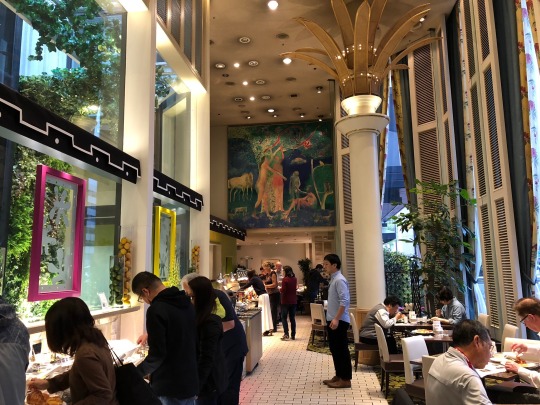
The first cherry blossom tree I have seen on this trip and it was across the road from the hotel.

Love the smart taxis around the place and I’m impressed by the suit and ties the drivers wear as well as the white lacy covers over the back of the seats.

People dress very well in Japan. Lots and lots of suits for the men

Traffic can be bad so you often see double and triple decked roads.

A pretty gray day to start. Down near the harbour where a big cruise ship was moored.

Cherry blossoms.

Typical sight seen in the countryside.

Venting machines are everywhere. This was at a stop we had along the way.
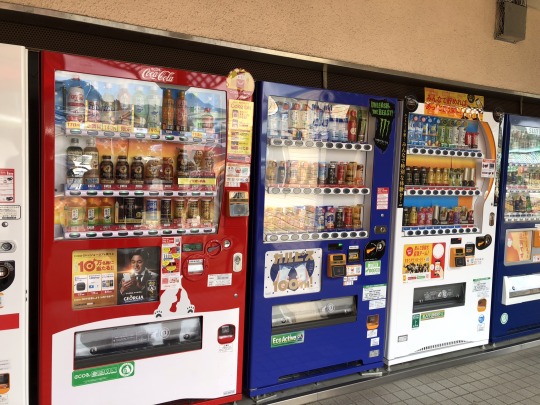
It seems to be common to see groups of men in suits travelling together.

Nagasaki Peace Park was built in 1955 on the epicentre of the Atomic bomb. Nagasaki wasn’t the original target but a city further west. However, the weather was overcast and the plane was running low on fuel so the pilot decided to drop the bomb on the city. 75,000 plus people were killed instantly. Many more died over the following months. The bomb landed on a gaol killing the 132 prisoners. All that is left are the gaols foundations.

Our first group photo in front of the Memorial Statue. The face is based on a Japanese but the body has a more muscular western body which refers to the fact the bomb can affect anyone. The finger pointing up is in fear of further bombs and the arm out to the side is indicating no more bombs. The eyes half shut is indicating meditation.
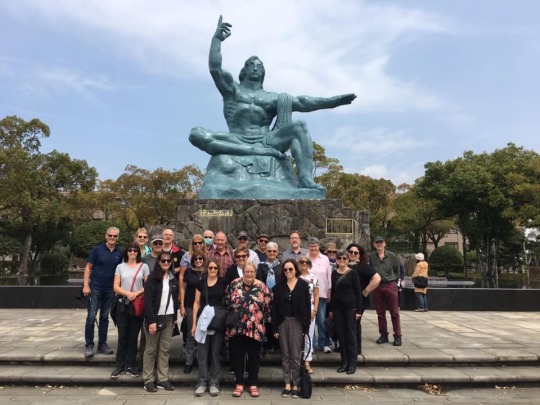
Crane memorial full of paper cranes.

Paper cranes for peace.
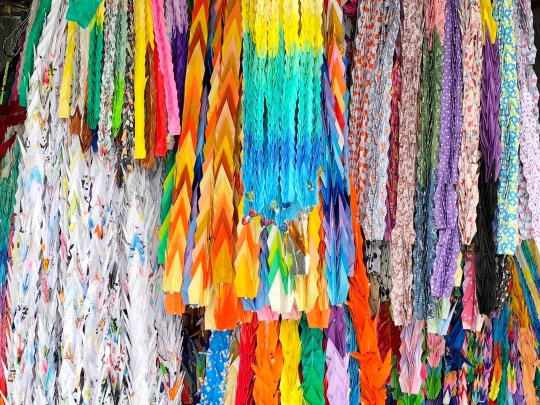
There was a lot of help for the city after the war from other parts of Japan as well as from many countries. There are a number of statues around the park indicating what countries gave help.
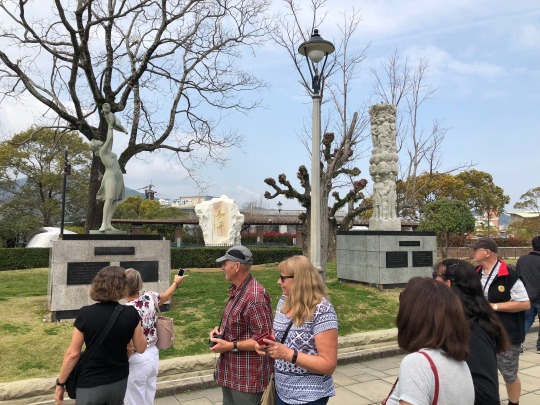
Angel wing fountain in the Park.
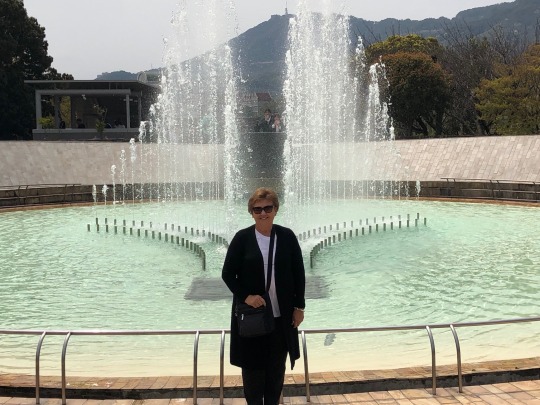
This man was 88 but was only 14 when the bomb was dropped. He was badly burnt and hit with glass. After he recovered he travelled to other parts of the world describing his experience. He spends time in the Park now talking to tourists. Water was a huge problem after the bomb drooped as it was in short supply and that was what all the survivors were begging for.
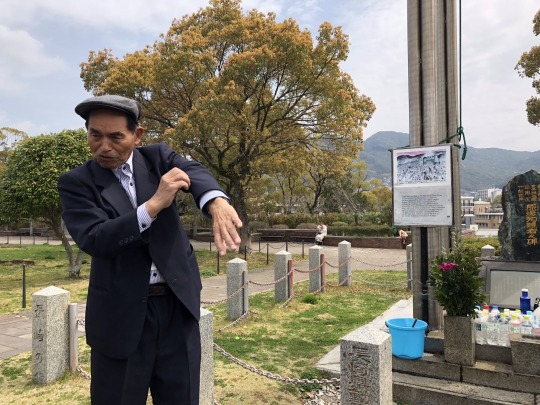
We watered the plants as an offering of water to the survivors.

Christine and Inosuke Hayasaki. He had been working at the Mitsubishi Arms Plant about 1.1kms north of the hypocenter. When the bomb dropped he was blown behind a pillar, which blocked the heat ray and the blast. Only the man and one other from 32 workers survived. His boss died on the spot.

Lovely flowers along the walkways.
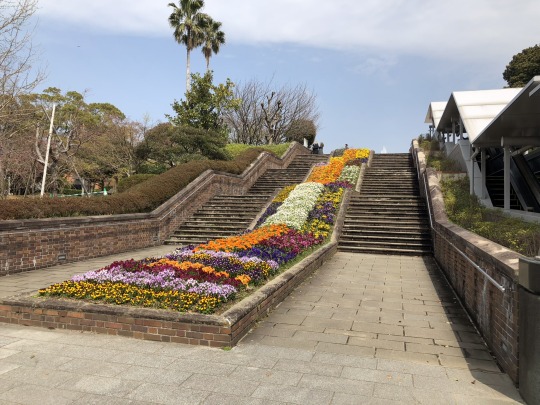
Al taking a photo of Balty.

This was a wall remanent from the Urakami Cathedral which was located about 500 metres northeast of the atomic bomb. The construction of the church began in 1895 and was completed in 1914. The wall was all that remained and was moved to the Peace Park.
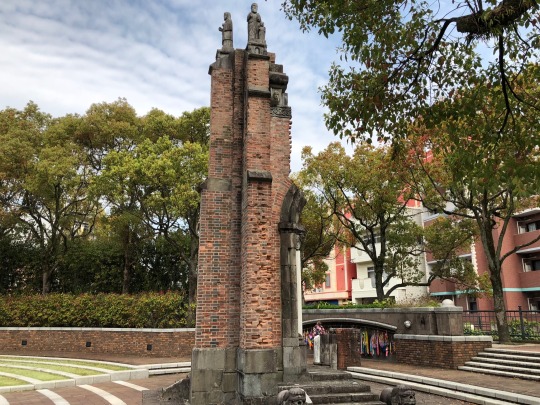
Memorial for those killed in the centre of where the bomb was dropped.

I think by the end of this trip we will be cherry blossomed out but the displays are beautiful.

Mother and child. A maternity hospital was hit by the bomb and this statue was erected in memory of the women and babies who were killed. The time and date of the bomb was listed underneath.

Group photo. Two in one day is a bit of a record and I think everyone was in both.

Nagasaki isn’t that attractive generally. It was pretty built up and gray looking.

Love these cute little van cars which are all over.

Everywhere you go there are always people wearing masks. Some to protect themselves against germs and also to protect other people from their germs.

For lunch we headed to a building with shops and lots and lots of restaurants. Each restaurant displayed the samples of their food but all done with plastic. There must be a big market for plastic food in Japan.
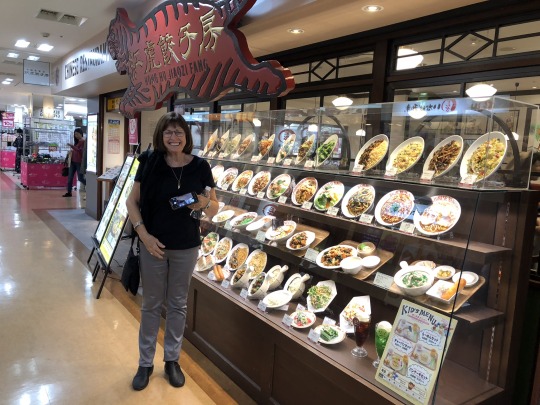
In 1571, Portuguese ships arrived at the harbour and since then Nagasaki has continued to develop as an international city. In 1636 under the orders of the Tokugawa Shogun, The Dejima was constructed by the efforts of 25 influential merchants at the tip of the cape of Nagasaki. The Portuguese were housed in the Dejima. Later the Dutch trading post in Hiradoat the time was moved to the Dejima and the exchange between Japan and Holland continued until the end of the Edo period. The Dejima fulfilled an important role as the only trading Port between Japan and Europe, the centre for Dutch study and the source for necessary information towards the modernisation of Japan.
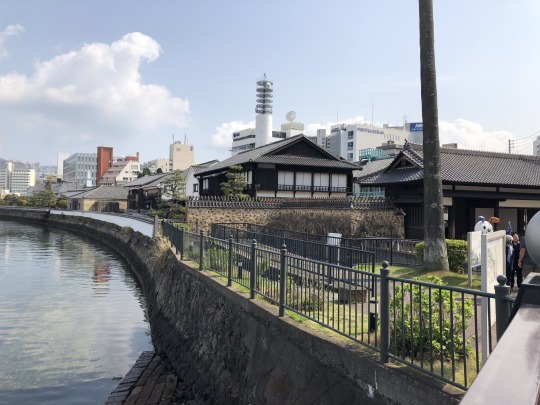
Samurais were warriors and worked for the Shoguns.
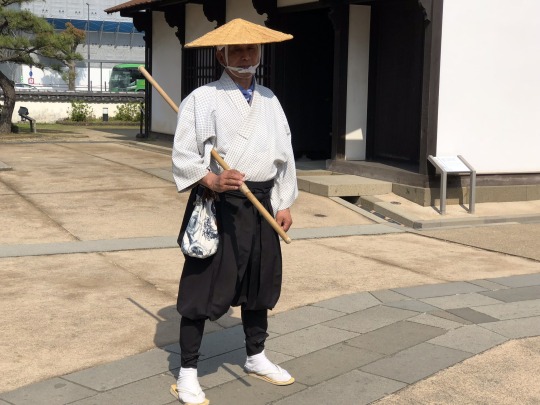
Chief Factor’s Residence

Lantern and hats.
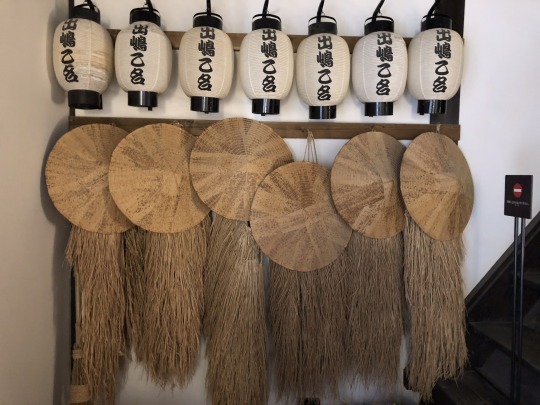
One of the old buildings housed activities from the past. This boy was enjoying drawing with a feather quill.

Walkways.

The former Dejima Protestant Seminary.
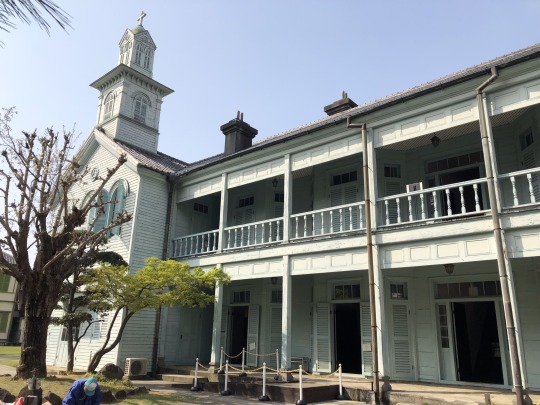
Lovely Japanese ladies in their kimonos.

Tulips which are remanents from the Dutch settlement.
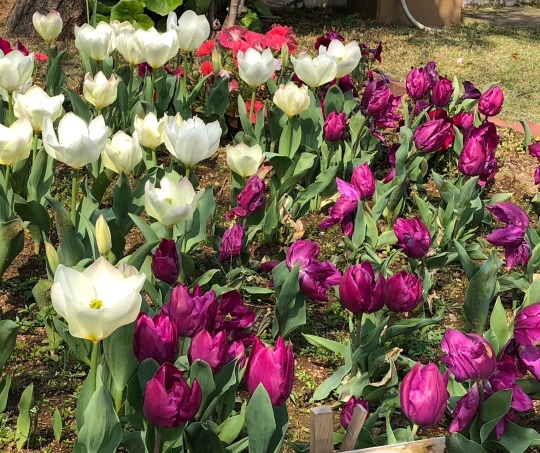
Friendly schoolboys in their military styled uniforms. Schools are on Spring Break at the moment. The holiday is usually longer but cut short this year because in May the Emperor is stepping aside for his son to become the new Emperor and there will be lots of National holidays during May. The new Emperor will be the 125 th Emperor since the 1st Century.

Old original wall of a garden. Sue and Cheryl in the background.
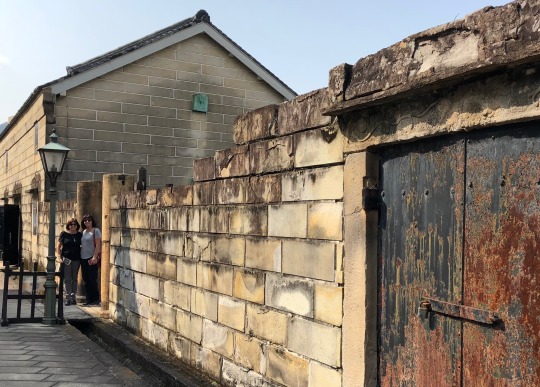
Oura Catholic Church which was built in 1875 by the Portuguese to provide a place of worship for Western traders.
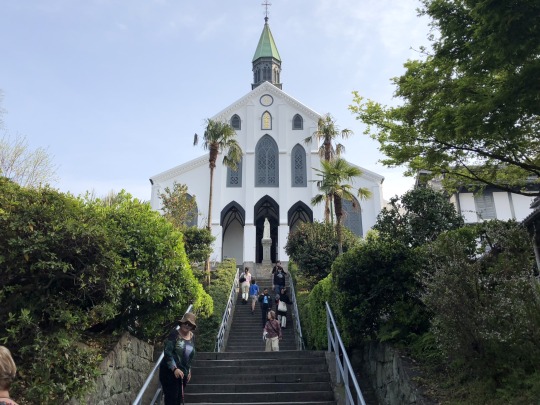
Coming out from prayer.

Looking up the side of the Church.
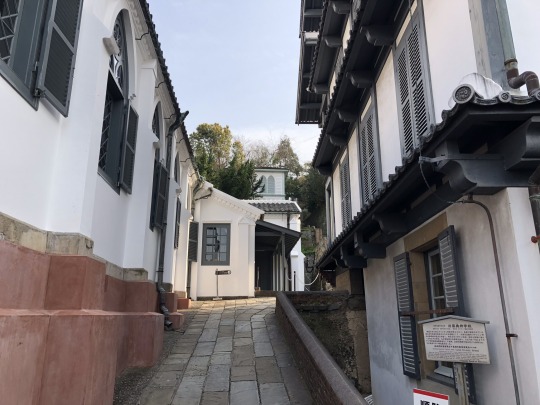
Gwenneth and John

Blossom.
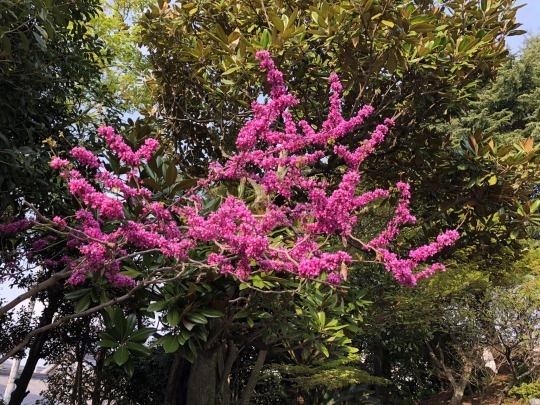
The group milling waiting to go into Glover Garden which was built for Thomas Blake Glover, a Scottish merchant who contributed to the modernization of Japan in shipbuilding, coal mining, and other fields. In it stands the Glover Residence, the oldest Western style house surviving in Japan.
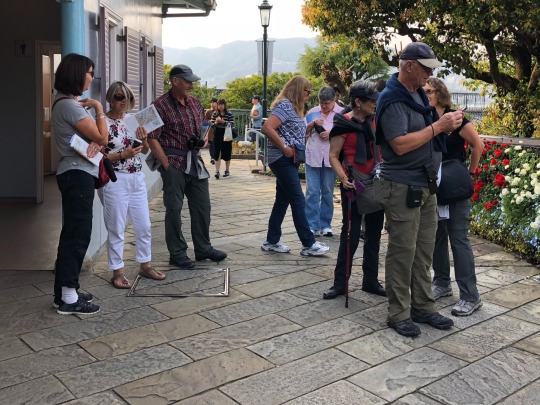
This building is now used as a tea room but was once a Jiyute (cafe).

Lovely walkways
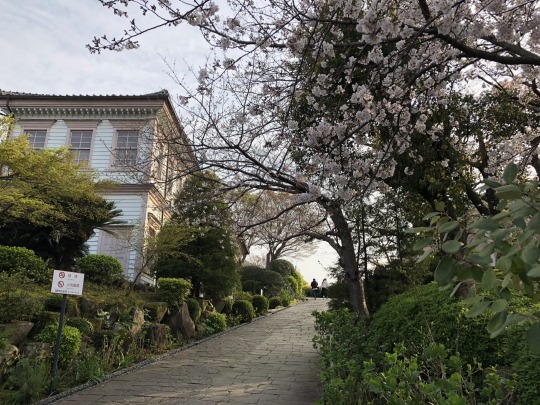
On one of the moving walkways that got us up the hill. There were two outside escalates and two moving walkways in the gardens so a very civilised way of getting up the hill.

Looking over part of the city.

Sara and I on the moving walkway.

This building,now on the top of the hill, was erected in 1898 and served as a domitory for crewmembers whilst their ship underwent repairs. It was known as the Mitsubishi No 2 Dock House. The building was originally adjacent to the dock of the Mitsubishi Nagasaki Shipyard.

The stunning blossoms certainly add colour to the gardens
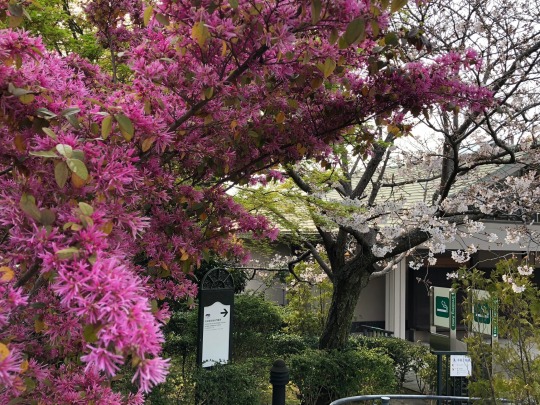
One of a number of lovely homes in the gardens.

Looking through the garden to the harbour. The gardens were beautiful. It was such a lovely area to walk through.

A statue of Madam Butterfly in the grounds of the garden. The story was based around this part of Japan.
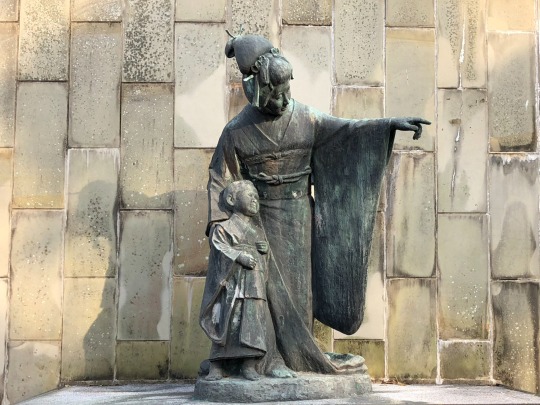
This was a big Holland America ship that was in port.ni can’t get away from these ships. There were quite a few westerners around the port. Japan doesn’t really have immigration or accepts refugees so it’s noticeable when you see anyone that isn’t Japanese.

0 notes
Text
Oura Church, Nagasaki
Oura Church (大浦天主堂), also known as the “Basilica of the Twenty-Six Holy Martyrs of Japan” is a Catholic church located near Glover Garden in Nagasaki. The church was first constructed by two french priests, who dedicated it to the 26 Martyrs who were crucified in Nagasaki in 1597.
Hotels Nagasaki Guided Tour JR Pass (All Kyushu)
Very near the famous Glover Garden, and about 2km from the…
View On WordPress
0 notes
Photo

Oura Catholic Church in Nagasaki pref. https://www.instagram.com/p/BoEhZSQHYkb/?utm_source=ig_tumblr_share&igshid=1rx6l22owchpa
0 notes
Text
Once hidden, the history of Japanese Christianity gains UN recognition
New Post has been published on https://pray-unceasingly.com/catholic-living/catholic-news/once-hidden-the-history-of-japanese-christianity-gains-un-recognition/
Once hidden, the history of Japanese Christianity gains UN recognition
Nagasaki, Japan, Jul 3, 2018 / 02:42 am (CNA/EWTN News).- Places of major importance for Japanese Christianity, including the Nagasaki basilica commemorating 26 Catholic martyrs, have been selected as UNESCO World Heritage sites.
“These sites bear unique testimony to a cultural tradition nurtured by hidden Christians in the Nagasaki region who secretly transmitted their faith during the period of prohibition from the 17th to the 19th century,” said the June 30 announcement from the U.N. Educational, Scientific and Cultural Organization.
“Together they reflect the earliest activities of Christian missionaries and settlers in Japan – the phase of encounter, followed by times of prohibition and persecution of the Christian faith and the final phase of the revitalization of Christian communities after the lifting of prohibition in 1873.”
All the sites are in the northwest part of the Japanese island of Kyushu.
Nagasaki’s Basilica of the Twenty-Six Holy Martyrs of Japan, also known as Oura Church, commemorates the 20 Japanese and six foreign-born Christians martyred for their faith in 1597 after Japanese leaders became increasingly suspicious of missionaries.
In a March 2015 ad limina visit with Japan’s Catholic bishops, Pope Francis reflected on these missionaries and the martyrs of early Japan.
“The embers of faith which the Holy Spirit ignited through the preaching of these evangelizers and sustained by the witness of the martyrs were kept safe,” Pope Francis said, “through the care of the lay faithful who maintained the Catholic community’s life of prayer and catechesis in the midst of great danger and persecution.”
Among the martyrs of 1597 were seminarian Saint Paul Miki and his companions.
Sentenced to die by crucifixion and lancing, they were first marched 600 miles to the city of Nagasaki. During the journey, they underwent public torture meant to terrorize other Japanese believers in Christ.
All 26 held out courageously, even singing the hymn of praise “Te Deum” when they arrived at the hill where they would be crucified.
St. Francis Xavier had brought Christianity to Japan in 1549, and he and other missionaries found significant receptivity to the Gospel. However, the massive persecution just decades later prompted many Japanese Christians to go into hiding for centuries.
Oura Church was built by French priests in 1864 in the Gothic style. It is the oldest Christian-related building in Japan, Agence France Presse says.
The cathedral is the site where, in 1865, nervous Japanese peasants approached a French priest. One woman told him “our hearts are the same as yours.” Soon the rest of the world learned that thousands of Japanese had secretly lived as Christians for centuries.
Oura Church was designated a national treasure by the Japanese government in 1933. It was damaged in the Aug. 9, 1945 atomic bombing of Nagasaki by U.S. forces.
Hara Castle is also selected for the UNESCO list. It is the location of the final stand of the Shimabara rebellion. The rebels were predominantly Japanese Catholics, while the besieging forces were Japanese forces of the Tokugawa shogunate, which had the support of Dutch Protestant allies. The castle fell in 1638, with the building razed and burned. Thousands of rebels were punished with crucifixion.
After the rebellion was suppressed, the ban on Christianity became even more strictly enforced.
The UNESCO World Heritage list will include 10 Christian villages including Sakitsu village in Amakusa, in the southwestern part of the city of Kumamoto. Many Christians practiced their faith in secret there.
In January 2017 the Japanese government said it would submit sites related to Christian persecution for consideration for the UNESCO World Heritage list. Sites’ inclusion on the list requires being “of outstanding universal value” and must meet other criteria set by UNESCO.
CNA Daily News – Asia – Pacific
0 notes

